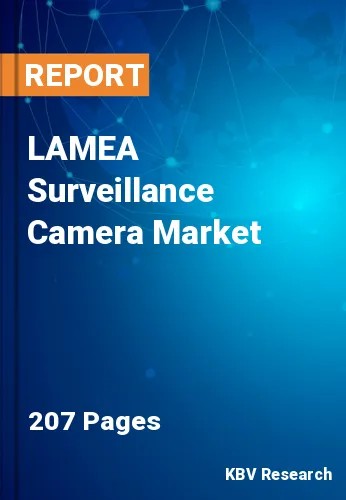The Latin America, Middle East and Africa Surveillance Camera Market would witness market growth of 12.7% CAGR during the forecast period (2023-2030). In the year 2026, the LAMEA market's volume is expected to surge to 81.6 million units, showcasing a growth of 14.3% (2023-2030).
Cloud technology has revolutionized the storage and management of surveillance data. Surveillance systems now offer cloud-based storage and remote access, allowing users to access video footage from anywhere at any time. This flexibility is precious for businesses and organizations with multiple locations or those seeking to centralize their surveillance data management. The future prospects of the market are marked by continued growth and ongoing technological advancements. The convergence of AI, IoT, and 5G technology is expected to drive further innovation and expand the market's reach.
Cost reduction is another factor contributing to market growth. As manufacturing processes have improved and economies of scale have been realized, the cost of surveillance cameras has decreased significantly. This affordability has made surveillance solutions accessible to a broader range of consumers and industries, further driving market expansion. Furthermore, stringent regulatory compliance requirements have compelled organizations in various sectors to invest in surveillance systems. Regulatory mandates pertaining to security and surveillance standards have been established to ensure the safety and integrity of critical infrastructure, healthcare facilities, financial institutions, and transportation hubs.
South Africa's largest city, Cape Town, employs surveillance cameras to address crime concerns. For instance, the "Shotspotter" system combines acoustic sensors and surveillance cameras to detect and locate gunshots in real time, aiding law enforcement in responding to incidents swiftly. These examples underscore the multifaceted use of surveillance cameras across nations in the LAMEA region, ranging from urban safety and transportation management to security at critical infrastructure and public spaces. The use of these cameras to tackle new challenges in these distinct and dynamic regions will develop along with technology. Businesses and organizations in the LAMEA region can now easily expand their surveillance infrastructure to accommodate growing needs. For example, retailers can add IoT-connected cameras to monitor additional store locations or warehouses, improving security and inventory management.
The Brazil market dominated the LAMEA Surveillance Camera Market by Country in 2022 and would continue to be a dominant market till 2030; thereby, achieving a market value of $1,591.6 million by 2030. The Argentina market is showcasing a CAGR of 13.3% during (2023 - 2030). Additionally, The UAE market would register a CAGR of 12.4% during (2023 - 2030).
Based on Deployment, the market is segmented into Outdoor, and Indoor. Based on Product Type, the market is segmented into IP-based (Wired, and Wi-Fi), Cellular Camera, and Analog Camera. Based on Resolution Capacity, the market is segmented into High Definition (HD), Full High Definition (FHD), and Ultra High Definition (UHD) (4K). Based on End-use, the market is segmented into Commercial Infrastructure, Industrial, Public Facilities, Military & Defense, Residential, and Others. Based on countries, the market is segmented into Brazil, Argentina, UAE, Saudi Arabia, South Africa, Nigeria, and Rest of LAMEA.
Free Valuable Insights: The Worldwide Surveillance Camera Market is Projected to reach USD 72.4 Billion by 2030, at a CAGR of 10.2%
The market research report covers the analysis of key stake holders of the market. Key companies profiled in the report include Eye Trax, Inc, Milesight Technology Co., Ltd., Swann Communications Pty. Ltd. (Infinova Corporation), Honeywell International, Inc., Cisco Systems, Inc., Nokia Corporation, Panasonic Holdings Corporation, Robert Bosch GmbH, Teledyne FLIR LLC (Teledyne Technologies Incorporated), and Zhejiang Dahua Technology Co., Ltd.
By Deployment (Volume, Million Units, USD Billion, 2019 to 2030)
By Product Type (Volume, Million Units, USD Billion, 2019 to 2030)
By Resolution Capacity (Volume, Million Units, USD Billion, 2019 to 2030)
By End-use (Volume, Million Units, USD Billion, 2019 to 2030)
By Country (Volume, Million Units, USD Billion, 2019 to 2030)
Our team of dedicated experts can provide you with attractive expansion opportunities for your business.

